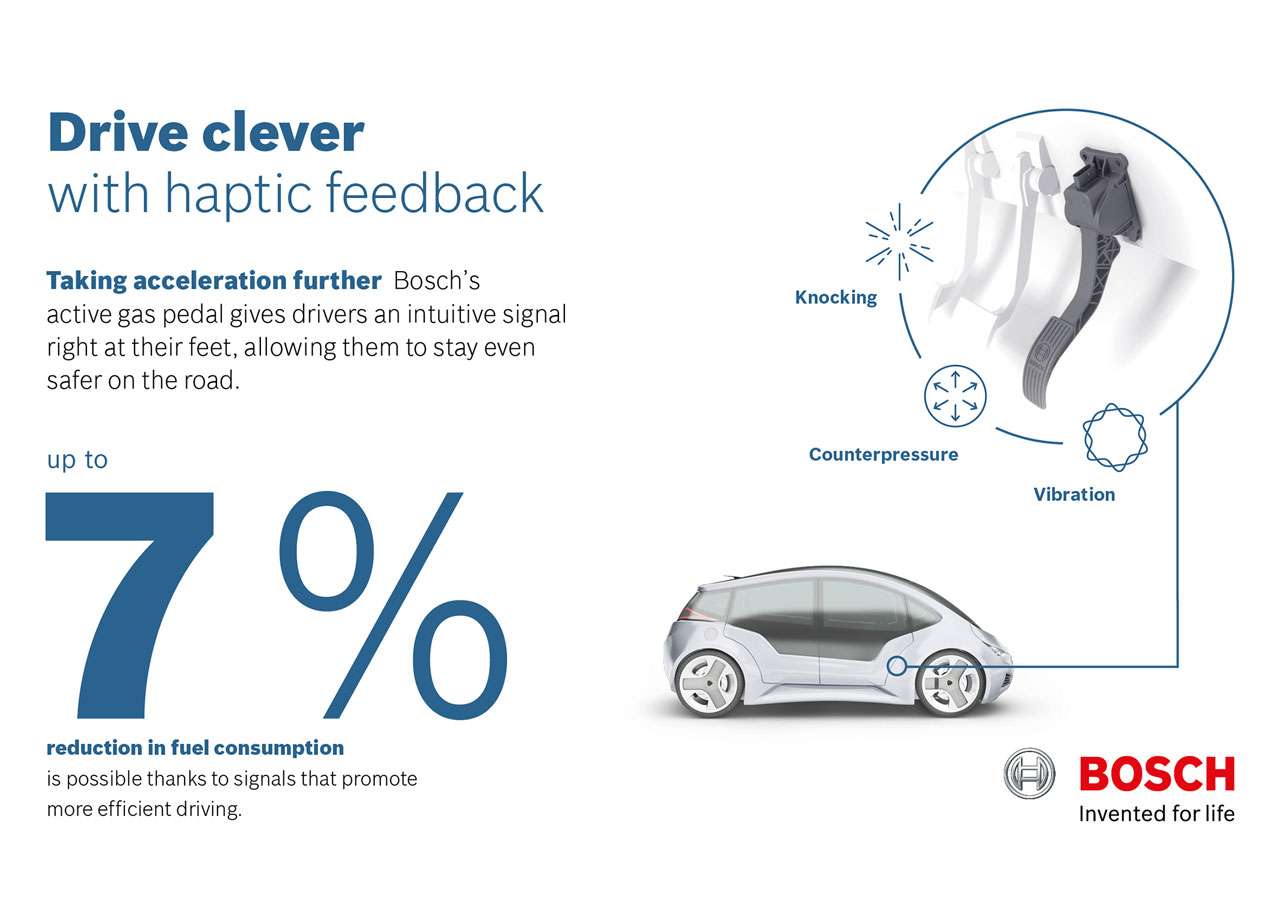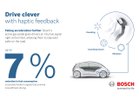
O artefato é designado para detectar o momento onde a aceleração do motor e a economia de combustível cheguem ao máximo de eficiência, e se necessário, o pedal empurra seu pé, a fim de eliminar a aceleração excedente e diminuir o consumo de combustível.
O Active Gas Pedal pode receber informações de câmeras de reconhecimento de sinais de trânsito, para que possa se autoprogramar e alertar o motorista caso ele ultrapasse a velocidade máxima determinada no atual trecho da via, além de notificar o motorista quando está prestes a ingressar em uma rua de mão única.
O pedal possui três tipos de feedback disponíveis para uso: vibração, contrapressão e rebote. A Bosch acredita que os motoristas irão se adaptar e responder rapidamente a cada uma das mensagens enviadas do Active Gas Pedal instintivamente.
É claro que os carros esportivos não irão deixar de terem a oportunidade de usar o Bosch Active Gas Pedal. O sistema pode ser programado para avisar quando o motor atinge o número máximo de rotações possível, já que este é o momento exato para troca de marcha em uma condução em pista, servindo como um complemento para os famosos shift lights, caso o carro tenha este recurso.
“I feel it in my toes”
The Bosch active gas pedal: gentle vibration can lighten pressure on the gas pedal and warn of wrong-way drivers
- Up to 7 percent lower fuel consumption.
- Connected with the navigation system: pedal warns about sharp bends
- Online data make real-time alert function possible
- Online-special: www.bosch-gaspedal.com
The driver’s foot is responsible for one-quarter of fuel consumption. Up to now, the only thing that could be done about this rule of thumb was to drive gently and take eco-driving courses. Now, however, Bosch has developed a technical aid in the shape of the active gas pedal: its gentle vibration tells drivers when they have crossed the line from light touch to lead foot. “The Bosch active gas pedal helps drivers save fuel – and alerts them to potentially dangerous situations as well,” says Stefan Seiberth, president of the Gasoline Systems division of Robert Bosch GmbH And if the vehicle has an assistance system, the pedal becomes a warning indicator: coupled with the navigation system or a camera that recognizes road signs, the innovative Bosch gas pedal gives drivers a haptic warning signal if, for example, they are approaching a dangerous bend at too high a speed.
The active gas pedal helps drivers to be very light-footed on the accelerator. The feedback they get from the pedal allows them to reduce fuel consumption by as much as 7 percent. And CO2 emissions are reduced accordingly. This is possible because the gas pedal can be networked with other automotive functions, such as the transmission. Up to now, the only indication drivers have had of the best time to shift gear has been in the form of small arrows on the instrument display. The active gas pedal comes with the option of a palpable indication of the best time to shift gear. “The pedal tells the driver when the economy and acceleration curves intersect,” Seiberth says. If the driver still wants to accelerate some more before shifting gear, however, applying a little extra pressure is enough.
Hybrids: advance warning of when the combustion engine will restart
Additional fuel-saving potential is available in conjunction with start-stop coasting, i.e. when the engine is stopped while still moving at speed in order to save fuel. Bosch estimates that the engine can be stopped in this way on 30 percent of all journeys. The gas pedal can be set to give an alert as soon as coasting mode makes sense. And with advancing powertrain electrification, this innovative technology has further benefits to offer. The pedal also opens up a lot of fuel-saving potential in hybrids, since it lets drivers know when the combustion engine is about to take over from the electric motor, so they can lighten the amount of pressure on the gas pedal.
But it is not only in the area of fuel economy that the active gas pedal comes into play. It can make cars safer as well. This is because the innovative component can be connected with a whole series of assistance systems. In connection with collision warning systems, for example, the system can create a vibrating signal warning drivers not to accelerate any further. A simple change to the software settings is all that is needed to tailor the type and force of haptic feedback to automakers’ specifications.
The gas pedal goes online: signals warn of wrong-way drivers or traffic jams ahead
The innovative Bosch gas pedal can also be connected with the navigation system, enabling it to warn drivers if, for example, they are approaching a sharp bend at too high a speed. In addition, the gas pedal can be coupled with a camera that recognizes speed-limit signs. If drivers exceed the speed limit, the gas pedal will warn them by vibrating or exerting counter-pressure. Internet connectivity opens up even more possibilities. The Bosch innovation is already designed for cars that are connected with their surroundings. And via the vibrating pedal, the connected car will pass on warnings about dangerous situations – wrong-way drivers, unexpected congestion, crossing traffic, and other hazards along the planned route – to the person at the wheel.
A detailed web-special on the connected gas pedal can be found online: www.bosch-gaspedal.com
Contact person for press inquiries:
Florian Flaig,
phone: +49 711 811-6282
Mobility Solutions is the largest Bosch Group business sector. According to preliminary figures, its 2015 sales came to 41,7 billion euros, or 60 percent of total group sales. This makes the Bosch Group one of the leading automotive suppliers. The Mobility Solutions business sector combines the group’s expertise in three mobility domains – automation, electrification, and connectivity – and offers its customers integrated mobility solutions. Its main areas of activity are injection technology and powertrain peripherals for internal-combustion engines, diverse solutions for powertrain electrification, vehicle safety systems, driver-assistance and automated functions, technology for user-friendly infotainment as well as vehicle-to-vehicle and vehicle-to-infrastructure communication, repair-shop concepts, and technology and services for the automotive aftermarket. Bosch is synonymous with important automotive innovations, such as electronic engine management, the ESP anti-skid system, and common-rail diesel technology.
The Bosch Group is a leading global supplier of technology and services. It employs roughly 375,000 associates worldwide (as of December 31, 2015). According to preliminary figures, the company generated sales of more than 70 billion euros in 2015. Its operations are divided into four business sectors: Mobility Solutions, Industrial Technology, Consumer Goods, and Energy and Building Technology. The Bosch Group comprises Robert Bosch GmbH and its roughly 440 subsidiaries and regional companies in some 60 countries. If its sales and service partners are included, then Bosch is represented in roughly 150 countries. This worldwide development, manufacturing, and sales network is the foundation for further growth. In 2015, Bosch applied for some 5,400 patents worldwide. The Bosch Group’s strategic objective is to deliver innovations for a connected life. Bosch improves quality of life worldwide with products and services that are innovative and spark enthusiasm. In short, Bosch creates technology that is “Invented for life.”
Further information is available online at www.bosch.com and www.bosch-press.com, http://twitter.com/BoschPresse.





Postar um comentário